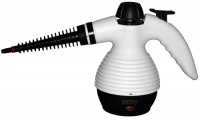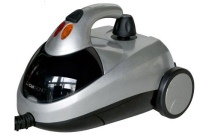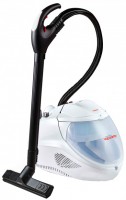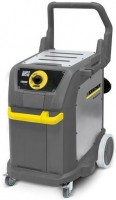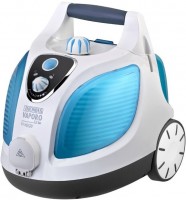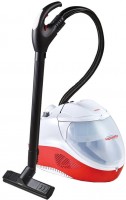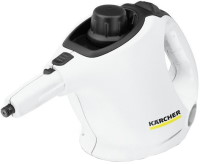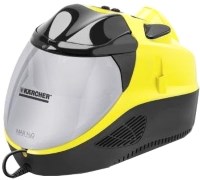Steam Cleaners Karcher
All Steam Cleaners Advanced filters → |
You might be interested in
Articles, reviews, useful tips
All materials
What to give to mom?
We have selected useful gift options that will please any mother — for health, comfortable rest, home and kitchen

TOP devices for a home with pets
Household appliances that will help you get rid of hair, purify and humidify the air and spy on your pet
Steam Cleaners: specifications, types
Type
Steam cleaners include compact models, which include handheld steam cleaners and steam mops, as well as full-fledged household for home and professional steam cleaners for offices and cleaning companies. More about each:
– Household. Devices designed for everyday use: steaming clothes, cleaning curtains, carpets, furniture, etc. It is this type that you should pay attention to if you are looking for a steam cleaner for regular use within the same apartment/house (or other tasks of a similar scale ). Most household models are similar in appearance and dimensions to ordinary vacuum cleaners.
– Professional. The most advanced type of modern steam cleaners. Professional models are distinguished primarily by high power and productivity, as well as a long operating time on a single refill. We emphasize that for domestic use such equipment is unnecessarily expensive and large; but for significant volumes of work – such as professional cleaning of large rooms – professional steam cleaners are simply irreplaceable.
– Handheld steam cleaner. Lightweight and compact steam cleaners that are held entirely in the hands during operation. Outwardly, they resemble electric kettles or manual garden sprayers. The power and productivity of such devices is small, they are intended mainly for small volume and relatively simp...le tasks.
– Steam mop. The basis of the design of the steam mop is a specific bar: a tank and a steam generator are installed on it, a working nozzle is attached to the bottom, and a handle to control the device is attached to the top. In terms of purpose, such models are similar to conventional mops, they are used mainly for cleaning on the floor; one of the key differences is that the steam device can be used not only for smooth surfaces, but also for carpets.
– Steam mop with portable. Devices that combine the capabilities of a steam mop and a portable steam cleaner. For more information about these varieties, see above, and their combination is as follows: a portable steam cleaner, which has a tank, a steam generator and a handle control in one common housing, is complemented by a bar, when installed, the device turns into a mop. The main advantage of such models is versatility; however, some of them are equipped not only with a bar, but also with a flexible hose, which further expands the possibilities of application.
– Household. Devices designed for everyday use: steaming clothes, cleaning curtains, carpets, furniture, etc. It is this type that you should pay attention to if you are looking for a steam cleaner for regular use within the same apartment/house (or other tasks of a similar scale ). Most household models are similar in appearance and dimensions to ordinary vacuum cleaners.
– Professional. The most advanced type of modern steam cleaners. Professional models are distinguished primarily by high power and productivity, as well as a long operating time on a single refill. We emphasize that for domestic use such equipment is unnecessarily expensive and large; but for significant volumes of work – such as professional cleaning of large rooms – professional steam cleaners are simply irreplaceable.
– Handheld steam cleaner. Lightweight and compact steam cleaners that are held entirely in the hands during operation. Outwardly, they resemble electric kettles or manual garden sprayers. The power and productivity of such devices is small, they are intended mainly for small volume and relatively simp...le tasks.
– Steam mop. The basis of the design of the steam mop is a specific bar: a tank and a steam generator are installed on it, a working nozzle is attached to the bottom, and a handle to control the device is attached to the top. In terms of purpose, such models are similar to conventional mops, they are used mainly for cleaning on the floor; one of the key differences is that the steam device can be used not only for smooth surfaces, but also for carpets.
– Steam mop with portable. Devices that combine the capabilities of a steam mop and a portable steam cleaner. For more information about these varieties, see above, and their combination is as follows: a portable steam cleaner, which has a tank, a steam generator and a handle control in one common housing, is complemented by a bar, when installed, the device turns into a mop. The main advantage of such models is versatility; however, some of them are equipped not only with a bar, but also with a flexible hose, which further expands the possibilities of application.
Steam vacuum cleaner
Devices that combine the capabilities of a traditional steam cleaner and a washing vacuum cleaner. In other words, such a device is capable of not only treating various surfaces with hot steam, but also carry out suction of softened contaminants. This greatly simplifies cleaning: you do not need to separately remove dirt with napkins, the cleaner will also cope with this. In addition, such devices can also be used like conventional vacuum cleaners – for traditional dry cleaning. On the other hand, this versatility has a noticeable effect on weight and cost, despite the fact that in fact it is required relatively rare. Therefore, there are few steam vacuum cleaners nowadays.
Note that any type of devices (see above) can have this feature, except for garment steamers (due to application specifics) and handheld models (due to size/weight restrictions). The format of the steam vacuum cleaner can also be different. Most often, steaming is carried out first, then suction, however, some devices are able to perform two functions at the same time – this can significantly speed up the process.
Note that any type of devices (see above) can have this feature, except for garment steamers (due to application specifics) and handheld models (due to size/weight restrictions). The format of the steam vacuum cleaner can also be different. Most often, steaming is carried out first, then suction, however, some devices are able to perform two functions at the same time – this can significantly speed up the process.
In box
In addition to the main unit of any steam cleaner, in which the actual conversion of water into steam takes place, steam cleaners are equipped with a different number of nozzles and accessories for various tasks. Among them, there are a floor nozzle, a carpet nozzle, a textile nozzle, a spot nozzle, an angle nozzle, a flat nozzle, a round brush, a brush, a tile grout brush, a fabric nozzle, a a window nozzle, a window squeegee, a flexible hose, an iron, an ironing board. A few words about them:
– Floor nozzle. Nozzle for cleaning floors – mostly smooth, without a special coverage (tiles, stone, etc.). It is used in combination with a bar or hose like a vacuum cleaner; the shape usually also resembles the nozzle of a vacuum cleaner. The design usually provides a brush to remove dirt, and the set may include a cloth, when installed, such a device turns into a fabric nozzle (see below).
- Nozzle for carpets. Wide nozzles for refreshing carpets,...textile paths, carpeted floors and other surfaces of similar texture. Their use allows you to restore the elasticity of carpet fibers under the influence of steam. Attachments of this type are in addition to floor nozzles, their frame allows you to effectively glide on carpets.
- Nozzle for textiles. A narrow elongated nozzle with many pinholes in a row for steam to escape. It is used to refresh clothes, smooth out light wrinkles, eliminate odors. Can be used to process clothes on hangers, curtains or curtains. Often, the design of the nozzle for textiles includes a special device for removing lint.
– Spot nozzle. A long and narrow nozzle with a very small outlet that produces a fine, directional steam jet. Designed mainly for work in small areas and in cramped conditions: for example, with a spot nozzle, you can effectively treat individual spots on the surface of a stove or angles between tiled walls. For more convenient and effective removal of dirt, the nozzle can be equipped with its own round brush.
– Angle nozzle. A nozzle used mainly for working in hard-to-reach places. In terms of capabilities, it is similar to the spot nozzle described above, however, the nozzle itself in such devices is bent at an angle relative to the nozzle itself (hence the name). This shape allows to easily reach where more traditional nozzles cannot reach – for example, to clean the space under the rim of the toilet.
- Flat nozzle. Nozzle in the form of a scraper with a narrow elongated nozzle to release steam. Used to remove stubborn dirt from flat surfaces. The power of steam softens them, and dried dirt is easily removed with the tip of a scraper.
– Round brush. A type of brush used in traditional steam cleaners (other than garment steamers) to clean floors and other surfaces. Usually, such a brush has a small size and is intended for cramped conditions and small spaces where a full-sized floor nozzle is not possible or does not make sense to use. In particular, it is convenient to clean the seams between tiles with such a device.
— Brush. A distinctive feature of such nozzles for steam cleaners is the presence of a characteristic bristle. The brushes are supposed to be used for working with floor coverings, plumbing, tiles, etc. First, the dirt on the surfaces is softened with steam, then it is easier to wipe them off with a brush. There are brushes with different lengths and stiffness of the pile. Nozzles with soft bristles are designed for cleaning sensitive surfaces to avoid scratches, with hard bristles for processing unpretentious materials.
- Tile grout brush. Specialized nozzles for effective cleaning of grime between tile joints. As a rule, they are a point nozzle, on both sides of which bristles are located. Due to the combination of high temperature and mechanical friction, even deeply embedded dirt is removed from the tile spaces.
— Window nozzle. Nozzle for washing windows with hot steam. Steam is supplied to the glass directly through such a device – this is how window nozzles differ from the squeegees described below. Otherwise, these two types of accessories are very similar in principle of operation: in both a special scraper is used to remove dirt from the glass. Also note that in some steam cleaners, the feature of a window nozzle is performed by another type of accessory (for example, a nozzle for textiles), on which a squeegee is installed; at the same time, if desired, the squeegee can be used separately.
– Window squeegee. Scraper for cleaning windows, used separately from the appliance: first, the glass is treated with hot steam, and then the moisture, together with the softened dirt, is manually collected with a squeegee. This procedure is somewhat more complicated than using the window nozzle described above, and also somewhat less effective; therefore, this type of accessory is rarely found in modern steam cleaners. And in some models, the window squeegee can be used both as a hand tool and as an adapter that turns another type of nozzle into a glass washer.
- Flexible hose. A flexible extension hose is attached to the outlet nozzle of the steam cleaner to allow operation in hard to reach places that are difficult to reach without the use of accessories. The flexible hose helps to direct the steam in the right direction and reach the most remote areas in any corner of the house. Other suitable specialized nozzles can be installed on the end of the hose. The presence of a flexible hose is indicated for portable models and steam mops, where it is supplied as an option. In household steam cleaners, the hose is an integral part of the standard equipment of the device.
– Iron. A classic iron connected to a steam cleaner with a hose. Such equipment actually turns the device into a steam generator for ironing; and models equipped with an ironing board are often comparable in functionality to full-fledged ironing systems.
– Ironing board. The classic ironing board is a horizontal surface used for ironing fabrics. Allows you to turn the steam cleaner into a system not only for the house cleaning but also for linen ironing.
Modern steam cleaners may come with items and accessories other than those described above. For example, steam vacuum cleaners (see above) can be equipped with "vacuum cleaner" nozzles – dust and crevice nozzles; and in more traditional models, you can find special nozzles for carpets.
– Floor nozzle. Nozzle for cleaning floors – mostly smooth, without a special coverage (tiles, stone, etc.). It is used in combination with a bar or hose like a vacuum cleaner; the shape usually also resembles the nozzle of a vacuum cleaner. The design usually provides a brush to remove dirt, and the set may include a cloth, when installed, such a device turns into a fabric nozzle (see below).
- Nozzle for carpets. Wide nozzles for refreshing carpets,...textile paths, carpeted floors and other surfaces of similar texture. Their use allows you to restore the elasticity of carpet fibers under the influence of steam. Attachments of this type are in addition to floor nozzles, their frame allows you to effectively glide on carpets.
- Nozzle for textiles. A narrow elongated nozzle with many pinholes in a row for steam to escape. It is used to refresh clothes, smooth out light wrinkles, eliminate odors. Can be used to process clothes on hangers, curtains or curtains. Often, the design of the nozzle for textiles includes a special device for removing lint.
– Spot nozzle. A long and narrow nozzle with a very small outlet that produces a fine, directional steam jet. Designed mainly for work in small areas and in cramped conditions: for example, with a spot nozzle, you can effectively treat individual spots on the surface of a stove or angles between tiled walls. For more convenient and effective removal of dirt, the nozzle can be equipped with its own round brush.
– Angle nozzle. A nozzle used mainly for working in hard-to-reach places. In terms of capabilities, it is similar to the spot nozzle described above, however, the nozzle itself in such devices is bent at an angle relative to the nozzle itself (hence the name). This shape allows to easily reach where more traditional nozzles cannot reach – for example, to clean the space under the rim of the toilet.
- Flat nozzle. Nozzle in the form of a scraper with a narrow elongated nozzle to release steam. Used to remove stubborn dirt from flat surfaces. The power of steam softens them, and dried dirt is easily removed with the tip of a scraper.
– Round brush. A type of brush used in traditional steam cleaners (other than garment steamers) to clean floors and other surfaces. Usually, such a brush has a small size and is intended for cramped conditions and small spaces where a full-sized floor nozzle is not possible or does not make sense to use. In particular, it is convenient to clean the seams between tiles with such a device.
— Brush. A distinctive feature of such nozzles for steam cleaners is the presence of a characteristic bristle. The brushes are supposed to be used for working with floor coverings, plumbing, tiles, etc. First, the dirt on the surfaces is softened with steam, then it is easier to wipe them off with a brush. There are brushes with different lengths and stiffness of the pile. Nozzles with soft bristles are designed for cleaning sensitive surfaces to avoid scratches, with hard bristles for processing unpretentious materials.
- Tile grout brush. Specialized nozzles for effective cleaning of grime between tile joints. As a rule, they are a point nozzle, on both sides of which bristles are located. Due to the combination of high temperature and mechanical friction, even deeply embedded dirt is removed from the tile spaces.
— Window nozzle. Nozzle for washing windows with hot steam. Steam is supplied to the glass directly through such a device – this is how window nozzles differ from the squeegees described below. Otherwise, these two types of accessories are very similar in principle of operation: in both a special scraper is used to remove dirt from the glass. Also note that in some steam cleaners, the feature of a window nozzle is performed by another type of accessory (for example, a nozzle for textiles), on which a squeegee is installed; at the same time, if desired, the squeegee can be used separately.
– Window squeegee. Scraper for cleaning windows, used separately from the appliance: first, the glass is treated with hot steam, and then the moisture, together with the softened dirt, is manually collected with a squeegee. This procedure is somewhat more complicated than using the window nozzle described above, and also somewhat less effective; therefore, this type of accessory is rarely found in modern steam cleaners. And in some models, the window squeegee can be used both as a hand tool and as an adapter that turns another type of nozzle into a glass washer.
- Flexible hose. A flexible extension hose is attached to the outlet nozzle of the steam cleaner to allow operation in hard to reach places that are difficult to reach without the use of accessories. The flexible hose helps to direct the steam in the right direction and reach the most remote areas in any corner of the house. Other suitable specialized nozzles can be installed on the end of the hose. The presence of a flexible hose is indicated for portable models and steam mops, where it is supplied as an option. In household steam cleaners, the hose is an integral part of the standard equipment of the device.
– Iron. A classic iron connected to a steam cleaner with a hose. Such equipment actually turns the device into a steam generator for ironing; and models equipped with an ironing board are often comparable in functionality to full-fledged ironing systems.
– Ironing board. The classic ironing board is a horizontal surface used for ironing fabrics. Allows you to turn the steam cleaner into a system not only for the house cleaning but also for linen ironing.
Modern steam cleaners may come with items and accessories other than those described above. For example, steam vacuum cleaners (see above) can be equipped with "vacuum cleaner" nozzles – dust and crevice nozzles; and in more traditional models, you can find special nozzles for carpets.
Power
Rated power consumed by the steam cleaner during operation. Usually, it is indicated by the maximum power consumption when used in normal mode, without abnormal situations.
In general, this parameter is secondary when choosing: manufacturers select power in such a way as to provide the necessary indicators of productivity, pressure, etc. However, some practical points are also associated with power. So, with the same performance (see "Steam intensity"), a more powerful device will spend less time heating water and generating steam; it can also be provided with a more capacious boiler (see "Water boiler volume"), which is useful for long-term continuous operation. On the other hand, such devices turn out to be more expensive, and often also heavier and larger than relatively “weak” steam cleaners, and besides, they load the mains more.
The second point related to power is the calculations of the load on the wiring and various electrical equipment (protective automation, AVRs, generators, etc.).
In general, this parameter is secondary when choosing: manufacturers select power in such a way as to provide the necessary indicators of productivity, pressure, etc. However, some practical points are also associated with power. So, with the same performance (see "Steam intensity"), a more powerful device will spend less time heating water and generating steam; it can also be provided with a more capacious boiler (see "Water boiler volume"), which is useful for long-term continuous operation. On the other hand, such devices turn out to be more expensive, and often also heavier and larger than relatively “weak” steam cleaners, and besides, they load the mains more.
The second point related to power is the calculations of the load on the wiring and various electrical equipment (protective automation, AVRs, generators, etc.).
Max. steam pressure
The maximum steam pressure at the outlet of the working nozzle that the steam cleaner can create.
High pressure has a positive effect on the intensity of impact and the depth of penetration of steam; this is especially important when removing old dirt, as well as when processing carpets, upholstery and other similar materials. On the other hand, an increase in operating pressure affects the weight, price and power consumption of the device.
As for specific figures, pressure up to 3 bar is considered very low; such indicators are found mainly among steam mops (see "Type"), as well as in the simplest household steam cleaners (including manual varieties). 3.1 - 4 bar – average figure; it, in particular, corresponds to most household devices, as well as the simplest professional models. And more than 4 bar can be found mainly in advanced units, although there are exceptions to this rule.
High pressure has a positive effect on the intensity of impact and the depth of penetration of steam; this is especially important when removing old dirt, as well as when processing carpets, upholstery and other similar materials. On the other hand, an increase in operating pressure affects the weight, price and power consumption of the device.
As for specific figures, pressure up to 3 bar is considered very low; such indicators are found mainly among steam mops (see "Type"), as well as in the simplest household steam cleaners (including manual varieties). 3.1 - 4 bar – average figure; it, in particular, corresponds to most household devices, as well as the simplest professional models. And more than 4 bar can be found mainly in advanced units, although there are exceptions to this rule.
Steam flow
The steam flow provided by the steam cleaner. For models with power and/or humidity controls, this item indicates the maximum possible value.
When choosing according to this indicator, note that the performance characterizes only the amount of water steam produced by the device per minute. The intensity of the impact of this steam on the treated surface/product can be different, first of all, it depends on the working pressure. Therefore, only devices with similar pressure indicators can be directly compared by this indicator. In such comparisons, it is worth assuming that high performance allows to cope with larger volumes of work faster, but requires more powerful heaters and capacious tanks – which, in turn, affects the dimensions, weight and price of the entire steam cleaner.
When choosing according to this indicator, note that the performance characterizes only the amount of water steam produced by the device per minute. The intensity of the impact of this steam on the treated surface/product can be different, first of all, it depends on the working pressure. Therefore, only devices with similar pressure indicators can be directly compared by this indicator. In such comparisons, it is worth assuming that high performance allows to cope with larger volumes of work faster, but requires more powerful heaters and capacious tanks – which, in turn, affects the dimensions, weight and price of the entire steam cleaner.
Boiler tank volume
The volume of the water boiler used in the steam cleaner.
First of all, we emphasize that you should not confuse the boiler and the water tank (see below). A boiler is a tank in which water is heated to form steam; in some models, such a tank is supplemented by a cold water tank, in others, the entire supply of water is located directly in the boiler. Accordingly, the meaning of this parameter depends on whether the unit has an additional tank or not.
If there is a separate tank in the design, then the volume of the boiler is rather a secondary indicator: it is selected in such a way as to provide the claimed performance characteristics, primarily productivity (and it is worth focus on these characteristics when choosing). If there is no tank, then the volume of the boiler directly depends on how much water will fit in the unit and how long it can work on one such “charge”. At the same time, an increase in volume allows you to work longer without refueling, but it affects the dimensions, weight, price, and often also the power consumption of the device (a more capacious boiler requires a more powerful heater).
First of all, we emphasize that you should not confuse the boiler and the water tank (see below). A boiler is a tank in which water is heated to form steam; in some models, such a tank is supplemented by a cold water tank, in others, the entire supply of water is located directly in the boiler. Accordingly, the meaning of this parameter depends on whether the unit has an additional tank or not.
If there is a separate tank in the design, then the volume of the boiler is rather a secondary indicator: it is selected in such a way as to provide the claimed performance characteristics, primarily productivity (and it is worth focus on these characteristics when choosing). If there is no tank, then the volume of the boiler directly depends on how much water will fit in the unit and how long it can work on one such “charge”. At the same time, an increase in volume allows you to work longer without refueling, but it affects the dimensions, weight, price, and often also the power consumption of the device (a more capacious boiler requires a more powerful heater).
Additional tank for water
The presence of a separate tank for cold water in the steam cleaner.
In any modern steam cleaner, there is at least a boiler — a container in which water is heated to a high temperature and steam is formed. However, in addition to the boiler, the design may also provide a separate reservoir for the supply of cold water. It allows you to optimize the work, avoid unnecessary energy consumption and increase the time of work at one water load. So, the boiler can be made small, and only the amount of water that is needed directly shortly can be heated in it. The additional tank from which the supply of hot water is replenished - on the contrary, can be quite voluminous. In addition, the reserve tank may provide the ability of adding water without turning off the unit, while this ability is not available for the boiler (first, you need to bleed the steam, reducing the pressure and temperature to a safe level).
In any modern steam cleaner, there is at least a boiler — a container in which water is heated to a high temperature and steam is formed. However, in addition to the boiler, the design may also provide a separate reservoir for the supply of cold water. It allows you to optimize the work, avoid unnecessary energy consumption and increase the time of work at one water load. So, the boiler can be made small, and only the amount of water that is needed directly shortly can be heated in it. The additional tank from which the supply of hot water is replenished - on the contrary, can be quite voluminous. In addition, the reserve tank may provide the ability of adding water without turning off the unit, while this ability is not available for the boiler (first, you need to bleed the steam, reducing the pressure and temperature to a safe level).
Water tank volume
The volume of the water tank provided in the device.
This parameter should not be confused with the volume of the boiler (see above): in this case, we are talking about a reservoir with a supply of cold water, from which such water enters the boiler for heating. Not every steam cleaner is equipped with such a tank - see "Options" for details. tank for water". As for volumes, a large capacity, on the one hand, allows you to work longer without refuelling. On the other hand, it affects the dimensions, weight and cost of the unit. Therefore, in handheld devices and steam mops (see "Type"), the volume of the tank does not even reach 1 litre — for such devices, compactness and light weight are more important than the ability to do without unnecessary refills. Similar tanks can also be found among household steam cleaners, but most of this equipment still holds 1 - 2 litres. And tanks of more than 2 litres are used mainly in powerful professional units.
This parameter should not be confused with the volume of the boiler (see above): in this case, we are talking about a reservoir with a supply of cold water, from which such water enters the boiler for heating. Not every steam cleaner is equipped with such a tank - see "Options" for details. tank for water". As for volumes, a large capacity, on the one hand, allows you to work longer without refuelling. On the other hand, it affects the dimensions, weight and cost of the unit. Therefore, in handheld devices and steam mops (see "Type"), the volume of the tank does not even reach 1 litre — for such devices, compactness and light weight are more important than the ability to do without unnecessary refills. Similar tanks can also be found among household steam cleaners, but most of this equipment still holds 1 - 2 litres. And tanks of more than 2 litres are used mainly in powerful professional units.
Detachable water tank
The presence of a water tank in the device, which has a removable design.
For more information about the tank itself, see "Additional water tank". And the detachable design makes refueling much easier. In particular, it allows you to fill the tank under the tap, while with a non-detachable tank, this possibility is often not available. And some models with this feature can be refueled during operation, without turning off the heating and without relieving pressure in the boiler (although it still will be useful to clarify this possibility). In addition, a detachable tank is much easier to clean or wash than a non-detachable one.
For more information about the tank itself, see "Additional water tank". And the detachable design makes refueling much easier. In particular, it allows you to fill the tank under the tap, while with a non-detachable tank, this possibility is often not available. And some models with this feature can be refueled during operation, without turning off the heating and without relieving pressure in the boiler (although it still will be useful to clarify this possibility). In addition, a detachable tank is much easier to clean or wash than a non-detachable one.
Dust collector capacity
The capacity of the dust collector installed in the steam vacuum cleaner (see above).
As in vacuum cleaners, the dust collector in such devices is a bag or other container for collecting garbage (we emphasize that this container has nothing to do with the boiler/water tank). A larger capacity, on the one hand, allows you to work longer without emptying the dust collector. On the other hand, it significantly affects the dimensions and weight of the entire unit. So this parameter is selected by the manufacturer depending on the type (see above) and the overall level of the steam cleaner. In steam mops and handheld models, dust collectors of more than 0.9 litres are extremely rare. Among household steam cleaners, values of 1.5 - 1.8 litres are not uncommon - this is comparable to the capacity of a traditional home vacuum cleaner using a cyclone system. And in professional units, this figure can exceed 10 litres.
As in vacuum cleaners, the dust collector in such devices is a bag or other container for collecting garbage (we emphasize that this container has nothing to do with the boiler/water tank). A larger capacity, on the one hand, allows you to work longer without emptying the dust collector. On the other hand, it significantly affects the dimensions and weight of the entire unit. So this parameter is selected by the manufacturer depending on the type (see above) and the overall level of the steam cleaner. In steam mops and handheld models, dust collectors of more than 0.9 litres are extremely rare. Among household steam cleaners, values of 1.5 - 1.8 litres are not uncommon - this is comparable to the capacity of a traditional home vacuum cleaner using a cyclone system. And in professional units, this figure can exceed 10 litres.
Continuous operation time
Approximate time that the unit is able to operate without interruption. This parameter is determined primarily by the performance and capacity of the boiler/tank (see above): when the water supply is exhausted, the work will have to pause to replenish the stock. At the same time, for models with humidity and/or power control (also see above), both the average time of continuous operation (at a certain standard mode), and the longest (at minimum intensity) or the shortest (at maximum) can be indicated; these details should be clarified separately.
It is worth saying that some models allow refueling with water right in the process of operation, but it also will be useful to clarify this possibility separately.
It is worth saying that some models allow refueling with water right in the process of operation, but it also will be useful to clarify this possibility separately.
Heating time
Heating time until steam is generated. The duration of the heating process directly depends on the power of the device and the volume of the water tank.
Note that the actual heating time may be less than the claimed one. For example, if the main tank is not filled full, and the design does not provide an additional tank for cold water. For a full guarantee, you should still focus on the value directly stated in the characteristics.
Note that the actual heating time may be less than the claimed one. For example, if the main tank is not filled full, and the design does not provide an additional tank for cold water. For a full guarantee, you should still focus on the value directly stated in the characteristics.
Steam humidity regulator
A regulator that allows to adjust the humidity of the steam getting out of the device.
The specific possibilities for adjusting the humidity can be different – up to the transformation of a jet of steam into a jet of hot water (in some models). However, anyway, the steam humidity regulation allows to further adjust the device to the specific situation. For example, to remove old dirt on tiles, stone and other similar surfaces, it is best to use the most saturated steam; but materials like furniture upholstery do not tolerate high humidity.
Also note that this function should not be confused with power control (see below) - in this case, only the amount of water steam in the air flow emitted by the device changes (without changing the speed of the flow itself). However, both of these types of settings may well be combined in one device.
The specific possibilities for adjusting the humidity can be different – up to the transformation of a jet of steam into a jet of hot water (in some models). However, anyway, the steam humidity regulation allows to further adjust the device to the specific situation. For example, to remove old dirt on tiles, stone and other similar surfaces, it is best to use the most saturated steam; but materials like furniture upholstery do not tolerate high humidity.
Also note that this function should not be confused with power control (see below) - in this case, only the amount of water steam in the air flow emitted by the device changes (without changing the speed of the flow itself). However, both of these types of settings may well be combined in one device.
Steam power regulator
A regulator that changes the power of the steam coming from the device, in other words, it overall speed and flow rate. Do not confuse this function with humidity control: the change in power is carried out mainly by changing the operating pressure, while the humidity may remain unchanged (and vice versa).
Steam cleaners with steam regulation can be easily adjusted to the specifics of the situation, selecting the optimal mode depending on the tasks and materials. For example, to remove old dirt, maximum intensity of impact may be required, and for regular cleaning such exposure will be unnecessary.
Steam cleaners with steam regulation can be easily adjusted to the specifics of the situation, selecting the optimal mode depending on the tasks and materials. For example, to remove old dirt, maximum intensity of impact may be required, and for regular cleaning such exposure will be unnecessary.
Safety valve
A protective device that prevents a critical increase in pressure in the working tank of the steam cleaner. When the pressure reaches a critical value, the safety valve opens and releases excess steam; this helps to avoid troubles such as damage to the boiler or even the explosion of the device and injury to people nearby.
Overheat protection
A protective system that turns off the device if the heater (or other part of the design) reaches a critical temperature. This can happen, in particular, due to lack of water in the tank or due to a failure of the control electronics. Overheat protection allows to avoid such situations with their unpleasant consequences – from a device breakdown to a fire.
Limescale protection
A system that prevents the formation of scale inside the steam cleaner's boiler.
Scale – insoluble limescale – produces several undesirable effects at once. Firstly, it reduces the efficiency of the heating element, and over time it can completely disable it. Secondly, particles of scale can peel off the surface of the boiler and contaminate the pipes, hoses and attachments of the steam cleaner. Thirdly, upon contact with the washed surface, such particles can form new contaminants, sometimes they will be very difficult to remove. Scale is formed especially quickly when using "hard" water, with a high content of calcium salts; however, even "soft" water is not insurance against this phenomenon.
To avoid all this, modern steam cleaners provide limescale protection. This function is usually performed by a special filter that removes calcium salts from the water; in other words, scale still settles in the device, however, not on critical structural elements, but on a part specially designed for this purpose. Note that filters have a limited resource and require periodic replacement (and the harder the water, the more often such a replacement will have to be done).
Scale – insoluble limescale – produces several undesirable effects at once. Firstly, it reduces the efficiency of the heating element, and over time it can completely disable it. Secondly, particles of scale can peel off the surface of the boiler and contaminate the pipes, hoses and attachments of the steam cleaner. Thirdly, upon contact with the washed surface, such particles can form new contaminants, sometimes they will be very difficult to remove. Scale is formed especially quickly when using "hard" water, with a high content of calcium salts; however, even "soft" water is not insurance against this phenomenon.
To avoid all this, modern steam cleaners provide limescale protection. This function is usually performed by a special filter that removes calcium salts from the water; in other words, scale still settles in the device, however, not on critical structural elements, but on a part specially designed for this purpose. Note that filters have a limited resource and require periodic replacement (and the harder the water, the more often such a replacement will have to be done).
Child lock
Safety system in case a curious little child gets to the steam cleaner. The specific way the child lock works may vary. So, often it provides blocking the opening of the water tank — during operation, there is high-temperature steam under high pressure in the tank, and opening it, a curious baby can easily get a serious burn or injury. In some models, the controls may also be locked so that the child cannot turn on the device or, taking advantage of the inattention of adults, change its mode of operation.
Nozzle compartment
A special compartment for storing nozzles and other accessories, usually located directly in the body of the steam cleaner.
Note that most often the nozzle compartment is designed for accessories of a relatively small size. However, even such a device greatly simplifies the storage and transportation of the device: for additional items you do not have to look for a separate package.
Note that most often the nozzle compartment is designed for accessories of a relatively small size. However, even such a device greatly simplifies the storage and transportation of the device: for additional items you do not have to look for a separate package.
Power cord rewind
The possibility of power cord rewind on a special device installed directly on (in) the body of the steam cleaner. This ensures at least additional convenience in storage/transportation – tthe power cord does not interfere with cleaning..
Note that for winding, a special coil is most often used – like those that are installed, for example, in vacuum cleaners. To unwind the cord from such a coil, you need to pull it, and the winding occurs automatically at the touch of a button. At the same time, the power cord does not have to be pulled out completely – you can choose the length so that it is guaranteed to reach the socket and at the same time does not create inconvenience. This provides additional comfort also while using.
Note that for winding, a special coil is most often used – like those that are installed, for example, in vacuum cleaners. To unwind the cord from such a coil, you need to pull it, and the winding occurs automatically at the touch of a button. At the same time, the power cord does not have to be pulled out completely – you can choose the length so that it is guaranteed to reach the socket and at the same time does not create inconvenience. This provides additional comfort also while using.
Steam hose length
The length of the steam supply hose supplied with the steam cleaner.
The longer the hose, the farther you can reach without moving the device itself. On the other hand, a large length can create inconvenience during storage and transportation, as well as when working at short distances.
The longer the hose, the farther you can reach without moving the device itself. On the other hand, a large length can create inconvenience during storage and transportation, as well as when working at short distances.
Power cord length
The length of the power cord with which the steam cleaner is connected to the mains. The longer the power cord- the farther from the outlet the device can operate, the more freedom of movement the user has. On the other hand, an unnecessarily long power cord can create difficulties both during operation and in storage/transportation. And when working away from the outlet, you can use an extension cord. Therefore, even in units designed for large areas (such as steam mops - see "Type"), the length of the power cord rarely exceeds 5 - 6 m.
Noise level
The approximate noise level generated by the unit during normal operation. Specified mainly for models with a steam vacuum function (see above) - more traditional steam cleaners are generally very quiet, and for them, this parameter does not need to be specifically specified.
The lower the noise level, the more comfortable the use of the steam cleaner, especially during prolonged use. On the other hand, an increase in power and performance inevitably leads to an increase in noise levels. this moment can be partly compensated for by various design tricks — but they affect the cost. As for specific values, most modern steam vacuum cleaners have a volume ranging from 67 dB (comparable to the sound of a busy street) to 85 dB (the level of a loud scream).
The lower the noise level, the more comfortable the use of the steam cleaner, especially during prolonged use. On the other hand, an increase in power and performance inevitably leads to an increase in noise levels. this moment can be partly compensated for by various design tricks — but they affect the cost. As for specific values, most modern steam vacuum cleaners have a volume ranging from 67 dB (comparable to the sound of a busy street) to 85 dB (the level of a loud scream).







